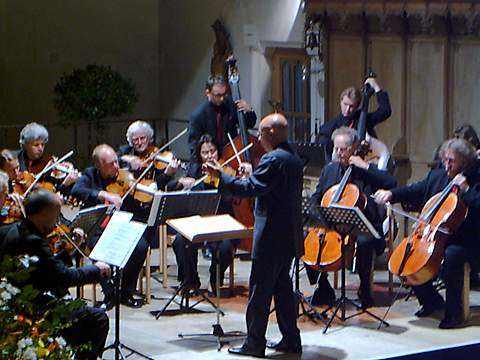|
<< -- 4 -- Tess Crebbin BEAUTY AND TRAGEDY

In the first movement, Largo, they lead into the main theme, a quote from the composer's first symphony, his Petrograd conservatory graduation work, which had brought him international fame. Like most men who propose to leave this life behind, the composer took an extensive look back over his life, at happier days that suddenly seem far away. Dennis Russell Davies creates a tragic and introspective mood by keeping the tempi slow, much slower than other conductors, but without dragging. The second movement, Allegretto Molto, showcases a 'Gopak' Ukrainian dance that once again integrates the Es-C-H (E flat, C, B) motif followed by the Death Dance from the composer's second piano trio. Eerily, Jews in Nazi concentration camps supposedly sung this as they were being forced to dig their own graves.
In the third movement, Allegretto, the D-Es-C-H (D, E flat, C, B) motif brings on a quote from the Siberian act of the opera Lady Macbeth, where tragic Katharina is sent into exile. Dennis Russell Davies kept these two movements, second and third, slower than the composer indicated and his intention is clear. It provides the setting for the final two movements: the composer had seen many of his close friends censored or even killed under the Soviet regime and tragedy filters through each note. Dennis Russell Davies keeps his ensemble tightly together; the tone is evenly balanced but unbearably intense. He is clearly looking to re-create the mood in which the work had been composed: comrades embracing in suffering, straight into death. There is a compulsion to look not merely for solving the considerable technical problems when performing what has been called one of the finest works of twentieth century chamber music but to go to the tragic core of the piece, something that Dennis Russell Davies achieves by asking from his ensemble a slow but noncompliant advance into oblivion.

Dennis Russell Davies conducts the Stuttgart Chamber Orchestra in Oberstdorf. Photo: Philip Crebbin
|
The forth and fifth movements are Largo and contain quotes of the third movement of the eleventh symphony and, again, from Lady Macbeth. The savage but vividly resonant chords that set off the forth movement have been interpreted as portraying the bombs falling onto Dresden, or the knock of Stalin's death squads on the door, but they might just as well mean the knock of death on the door of the composer. There is no more concealment of drama, no compressing of emotions. The ensemble extirpates any guise of nicety and opens the music right up, extending into the very core of dramatic suffering by exploding into an accusative mood and extorting a price: security is gone and the audience shifts uneasily in their seats. The music does not seduce any longer, it hits home, hard. The tempo is slow again, depicting an unwanted but unavoidable journey into death that cannot be dragged out much longer although one wants to cling to life. It is, after all, one of the bleakest works that we know of in chamber music. The catastrophic force that Dennis Russell Davies extorts from his orchestra representing the final convulsions of the universal casualty of war and oppression is deliberate and calculating in its slow approach: you think you might escape but you cannot.
Continue >>
Copyright © 14 August 2004
Tess Crebbin, Germany

|

